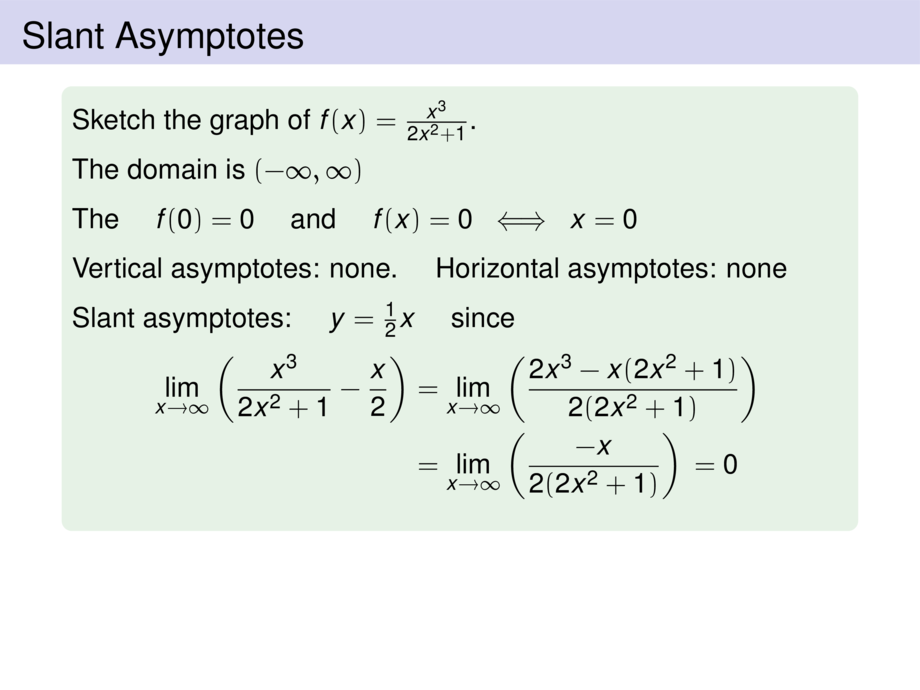



































































































90/121
\begin{frame}
\frametitle{Slant Asymptotes}
\begin{exampleblock}{}
Sketch the graph of $f(x) = \frac{x^3}{2x^2+1}$.
\pause\medskip
\only<-17>{
The domain is \pause $(-\infty,\infty)$
\pause\medskip
The \quad $f(0) = \pause 0$ \quad\pause and \quad $f(x) = 0 \;\iff\; \pause x = 0$
\pause\medskip
Vertical asymptotes: \pause none. \quad \pause Horizontal asymptotes: \pause none
\pause\medskip
Slant asymptotes: \pause \quad $y = \frac{1}{2}x$ \quad\pause since
\begin{talign}
\lim_{x\to \infty} \left(\frac{x^3}{2x^2+1} - \frac{x}{2}\right)
&\mpause[1]{= \lim_{x\to \infty} \left(\frac{2x^3 - x(2x^2+1)}{2(2x^2+1)}\right) }\\
&\mpause[2]{= \lim_{x\to \infty} \left(\frac{-x}{2(2x^2+1)}\right) }
\mpause[3]{= 0 }
\end{talign}
}
\only<18->{
\pause[18]\vspace{-2.5ex}
\begin{talign}
f'(x) = \mpause[1]{ \frac{3x^2(2x^2+1) - x^3(4x)}{(2x^2+1)^2} }
\mpause[2]{ = \frac{2x^4 + 3x^2}{(2x^2+1)^2} }
\mpause[3]{ = \frac{x^2(2x^2 + 3)}{(2x^2+1)^2} }
\end{talign}
\pause\pause\pause\pause
Thus $f'(x) > 0$ for all $x\ne 0$. \pause Hence increasing on $(-\infty,\infty)$.
\pause\medskip
Local minima, maxima: \pause none (since $f'$ does not change sign)
\pause\medskip
We have\vspace{-3ex}
\begin{talign}
f''(x) = %&= \mpause[1]{ \frac{(8x^3 + 6x)(2x^2+1)^2 - (2x^4 +3x^2)2(2x^2+1)4x}{(2x^2+1)^4} } \\
\mpause[1]{ -\frac{2x(2x^2 - 3)}{(2x^2+1)^3} }
\end{talign}\vspace{-2ex}
\pause\pause
Thus \quad $f''(x) = 0 \;\iff\;$ \quad\pause $x = 0$ \quad or \quad $x = \pm \sqrt{3/2}$
\begin{tabular}{|c|c|l|}
\hline
Interval & $f''(x)$ & \\
\hline
\mpause[1]{ $x < -\sqrt{3/2}$ } & \mpause[5]{+} & \mpause{ concave up on $(-\infty,-\sqrt{3/2})$ } \\
\hline
\mpause[2]{ $-\sqrt{3/2} < x < 0$ } & \mpause[7]{-} & \mpause{ concave down on $(-\sqrt{3/2},0)$ } \\
\hline
\mpause[3]{ $0 < x < \sqrt{3/2}$ } & \mpause[9]{+} & \mpause{ concave up on $(0,\sqrt{3/2})$ } \\
\hline
\mpause[4]{ $\sqrt{3/2} < x$ } & \mpause[11]{-} & \mpause{ concave up down $(\sqrt{3/2},\infty)$ } \\
\hline
\end{tabular}
\pause\pause\pause\pause\pause\pause\pause\pause\pause\pause\pause\pause\pause
Inflection points: \pause $(-\sqrt{\frac{3}{2}},-\frac{3}{8}\sqrt{\frac{3}{2}})$, $(0,0)$ and $(\sqrt{\frac{3}{2}},\frac{3}{8}\sqrt{\frac{3}{2}})$
}
\end{exampleblock}
\vspace{10cm}
\end{frame}

